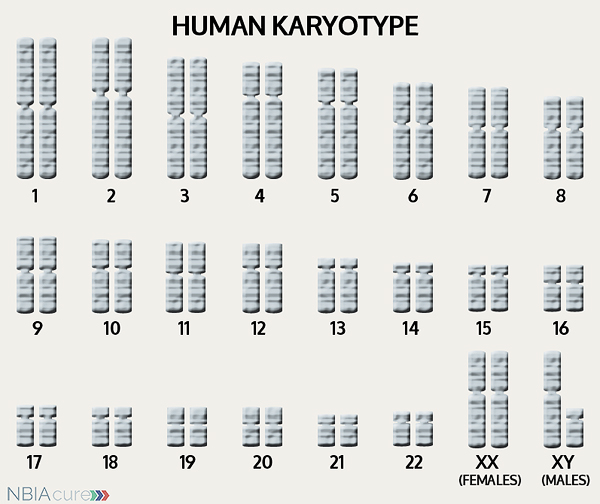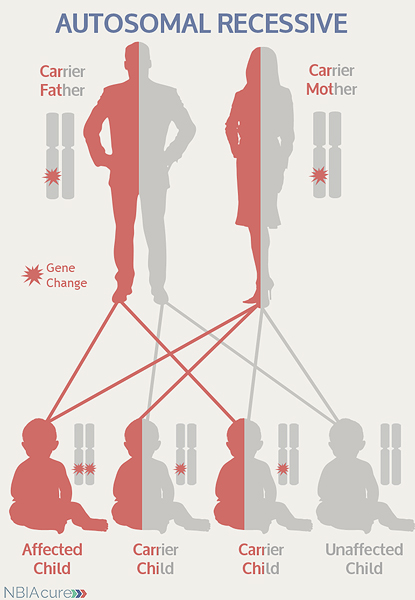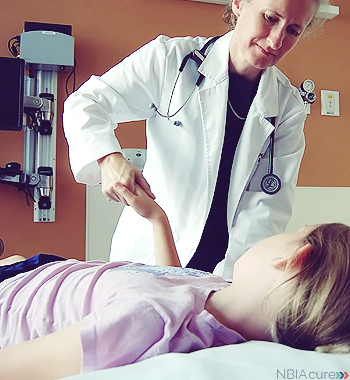Kufor-Rakeb syndrome is a NBIA disorder that is characterized by juvenile parkinsonism, progressive cognitive decline, abnormal eye movements and involuntary jerking of the facial and finger muscles. This is a very rare NBIA disorder with a few affected families in the U.S., Italy, South America, the Middle East and Asia.
SYMPTOMS
Symptoms of Kufor-Rakeb syndrome typically start to appear around adolescence (age 10-19), but can appear during young adulthood.
Common symptoms include:
Parkinsonism (symptoms similar to Parkinson’s disease)
- Symptoms begin in childhood
- Bradykinesia (slow movement)
- Rigidity (stiffness)
- Tremors (shaking)
- Chin and tongue tremors
- Arm tremors not typically seen
Oculogyric dystonic spasms (rotating of the eye balls into a fixed position, usually upward)
Pyramidal tract (motor pathway between brain and spine) signs
- Hyperreflexia (overactive reflexes)
- Spasticity (stiff or rigid muscles)
- Paresis (weakness of voluntary movement)
- Babinski sign (Plantar reflex)
- When the sole of the foot is rubbed with a blunt object, the big toe flexes upwards
Facial-faucial-finger myoclonus (quick, involuntary jerking of the facial and finger muscles)
Supranuclear gaze palsy (inability to look in a particular direction because of brain impairment)
Cognitive (mental) decline
- More research is needed to determine the level of impairment
- Can lead to dementia
Visual hallucinations
CAUSE/GENETICS
 The human body is made up of millions of cells. Inside every cell there is a structure called DNA, which is like an instruction book. DNA contains detailed steps about how all the parts of the body are put together and how they work. However, DNA contains too much information to fit into a single “book,” so it is packaged into multiple volumes called chromosomes. Humans typically have 46 total chromosomes that are organized in 23 pairs. There are two copies of each chromosome because we receive one set of 23 chromosomes from our biological mother and the other set of 23 from our biological father. Chromosomes 1-22 are called autosomes and the last pair is called the sex chromosomes because they determine a person’s gender. Females have two X chromosomes and males have one X and one Y.
The human body is made up of millions of cells. Inside every cell there is a structure called DNA, which is like an instruction book. DNA contains detailed steps about how all the parts of the body are put together and how they work. However, DNA contains too much information to fit into a single “book,” so it is packaged into multiple volumes called chromosomes. Humans typically have 46 total chromosomes that are organized in 23 pairs. There are two copies of each chromosome because we receive one set of 23 chromosomes from our biological mother and the other set of 23 from our biological father. Chromosomes 1-22 are called autosomes and the last pair is called the sex chromosomes because they determine a person’s gender. Females have two X chromosomes and males have one X and one Y.
If DNA is the body’s instruction book and it is stored in multiple volumes (called chromosomes), then genes would be the individual chapters of those books. Genes are small pieces of DNA that regulate certain parts or functions of the body. Sometimes multiple genes (or chapters) are needed to control one function. Other times, just one gene (or chapter) can influence multiple functions. Since there are two copies of each chromosome, there are also two copies of each gene. In some gene pairs, both copies need to be expressed (or turned on) in order for them to do their job correctly. For other genes pairs, only one copy needs to be expressed.
When a single cell in the human body divides and replicates, its DNA is also replicated. This replication process is usually very accurate but sometimes the body can make a mistake and create a “typo” (or mutation). Just like a typo in a book, a mutation in the DNA can be unnoticeable, harmless, or serious. A mutation with serious consequences can result in a part of the body not developing correctly or a particular function not working properly.
In the case of NBIA disorders, changes in certain genes cause a person to develop their particular type of NBIA. Changes in these NBIA genes lead to the groups of symptoms we observe, although we do not yet understand how the changed genes cause many of these findings. ATP13A2 (also called PARK9) is the only gene known to cause Kufor-Rakeb syndrome. ATP13A2’s main job is to tell the body’s cells how to make an enzyme called ATPase 13A2, which is responsible for transporting cations (positively charged atoms or molecules).
As mentioned earlier, humans have a total of 23 pairs of chromosomes. Half of these chromosomes are passed down (or inherited) from the biological mother and half from the biological father. The way in which a gene change is passed down from parents to child varies from gene to gene. The ATP13A2 gene that is altered in those with Kufor-Rakeb syndrome is inherited in an autosomal recessive manner.
“Autosomal” refers to the fact that the ATP13A2 gene is located on chromosome 1, which is one of the autosomes (chromosome pairs 1-22). Since the sex chromosomes are not involved, males and females are equally likely to inherit a mutation located in the autosomes. “Recessive” refers to the fact that a mutation must be present in both copies of the ATP13A2 gene for a person to have Kufor-Rakeb syndrome. If an individual has only one DCAF17 mutation, then they are called a “carrier” for Kufor-Rakeb syndrome. Carriers do not have health problems related to the mutation and often do not know they carry a recessive gene mutation. However, if two Kufor-Rakeb syndrome carriers have a child together, then there is a 25% chance that they will both pass on their recessive ATP13A2 gene mutations and have a child with Kufor-Rakeb syndrome.
 As seen in the image to the left, in a pregnancy between two Kufor-Rakeb syndrome carriers:
As seen in the image to the left, in a pregnancy between two Kufor-Rakeb syndrome carriers:
- There is a 25% chance of the child having Kufor-Rakeb syndrome
- There is a 50% chance that the child will be a carrier like his/her parents
- There is a 25% chance that the child will not have Kufor-Rakeb syndrome or be a carrier
DIAGNOSIS & TESTING
A brain MRI is a standard diagnostic tool for all NBIA disorders. MRI stands for magnetic resonance imaging. An MRI produces a picture of the body that is created using a magnetic field and a computer. The technology used in an MRI is different from that of an x-ray. An MRI is painless and is even considered safe to do during pregnancy. Sometimes an MRI is done of the whole body, but more often, a doctor will order an MRI of one particular part of the body.
Evidence of iron accumulation on a brain MRI is often an important clue leading to diagnosis. A T2 sequence is the preferred type of MRI for NBIA diagnosis because it is highly sensitive to the detection of brain iron.
MRI findings for Kufor-Rakeb syndrome include:
- Hypointensity (darkness) in the globus pallidus, putamen, and caudate on T2 MRI
- The dark patches indicate iron accumulation
- Only some individuals may have iron accumulation
- It may develop late in the disease course
- It may only be associated with more severe cases
- Generalized cerebral and cerebellar atrophy (decrease in cerebellum and overall brain size)
- Possible progressive atrophy of the pyramids (decrease in overall brain stem size)
Diagnosis of Kufor-Rakeb syndrome can be confirmed through genetic testing of the ATP13A2 gene to find gene changes. Genetic testing is done through sequence analysis.
Rarely, an individual with the signs and symptoms of Kufor-Rakeb syndrome may have only one or no ATP13A2 gene changes identified. This can happen because the genetic testing is not perfect and has certain limitations. It does not mean the person does not have Kufor-Rakeb syndrome; it may just mean we do not yet have the technology to find the hidden gene changes. In these cases it becomes very important to have doctors experienced with Kufor-Rakeb syndrome review the MRI and the person’s symptoms very carefully to be as sure as possible of the diagnosis.
MANAGEMENT
 There is no standard treatment for Kufor-Rakeb syndrome. Diagnosed individuals are managed by a team of medical professionals that recommends treatments based on current symptoms.
There is no standard treatment for Kufor-Rakeb syndrome. Diagnosed individuals are managed by a team of medical professionals that recommends treatments based on current symptoms.
After diagnosis, individuals with Kufor-Rakeb syndrome are recommended to get the following evaluations to determine the extent of their disease:
- Neurologic examination for dystonia, rigidity, and spasticity, and/or parkinsonism
- Ophthalmologic assessment for evidence of eye movement abnormalities
- Assessment for physical therapy, occupational therapy, and/or speech therapy
- Medical genetics consultation
The symptoms of parkinsonism can be treated with the same medications used in Parkinson’s disease. Treatment with dopamine agonist drugs (like levodopa) must be started and monitored carefully. In the beginning, the dose is increased gradually until both the patient and doctor feel symptoms are under control. While taking dopaminergic drugs, individuals must be regularly monitored for adverse neuropsychiatric effects, psychiatric symptoms and worsening of parkinsonism. There is often short-term great benefit from Parkinson’s medications. However, this usually only lasts a few years and is often eventually limited by the development of dyskinesias (a common side effect that creates unwanted movement).
Even after a diagnosis has been made and the appropriate therapies have been decided, it is recommended to continue long-term surveillance to decrease the impact of Kufor-Rakeb syndrome symptoms and increase quality of life.
Long-term surveillance for Kufor-Rakeb syndrome can include:
- Medication for spasticity, dystonia, and/or parkinsonism
- Nutrition
- Monitoring of height and weight in children
- Swallowing evaluation and regular dietary assessments
- Assure adequate nutrition
- Prevent aspiration
- Gastrostomy tube placement (as needed)
- Adverse neuropsychiatric effects
- Psychiatric symptoms
- Worsening of parkinsonism
PROGRESSION
The symptoms of Kufor-Rakeb syndrome typically progress at a slow rate.
The average lifespan varies for individuals with Kufor-Rakeb syndrome, but due to improvements in medical care, more affected individuals are now living into adulthood.
Copyright © 2014 by NBIAcure.org. All rights reserved.